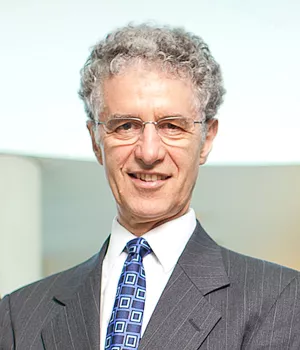
Inaugural director named for Institute for Management and Innovation
On his first day of work in 1970, Professor Hugh Gunz took his new chemistry PhD to a Shell petrochemicals plant in the United Kingdom, looked around, and thought, I don’t understand what people are saying.
“I was speaking the language of a scientist and my colleagues were speaking the language of business and management,” says Gunz, who was recently appointed the inaugural Director of the University of Toronto Mississauga’s new Institute for Management and Innovation (IMI). Over time, Gunz’s interest in management grew; he subsequently completed a Dp.B.A, a PhD and joined the faculty of a British business school before moving to Canada.
IMI is designed to ensure that graduates can avoid Gunz’s initial experience, and seamlessly bridge the gap between management and science. A new academic and research unit launching July 1, IMI creates a hub for convergence and crosses interdisciplinary boundaries to offer programs that combine the study of management with those of key disciplines, professions or particular industrial sectors.
“At UTM, we teach management differently because we teach it in conjunction with fields of study,” says Gunz, a management professor who has held cross-appointments in the Faculty of Nursing, the Centre for Industrial Relations, and the Institute for Health Policy, Management and Evaluation. “For instance, students in the Master of Biotechnology learn about biotechnology, and they also learn about management in the biotechnology industry.”
IMI will bring together UTM’s integrative management programs in a single home unit for the first time. Gunz says this close association will assist administrators to effectively develop similar programs, as well as develop research to support the institute’s educational mandate.
“Our goal is to produce mission-centred managers who understand the science as well as the business for which they are being educated,” says Gunz. “They can hit the ground running when they arrive on the job because they fully understand how the organization and sector function.”
Over the next two years, Gunz will provide shape and structure to the new institute. He’s planning a number of activities to introduce IMI to the UTM and greater Mississauga communities. In the works are seminar series, such as one to introduce budding scientists to the “ins and outs” of commercialization, and conferences to draw together interested researchers.
He’ll also be overseeing the move to IMI’s new physical home in the $35-million Innovation Complex.
Although he says establishing IMI will have its challenges, as every new opportunity does, he’s not worried about success.
“Astronomers refer to the ‘Goldilocks zone’, where it’s not too hot and not too cold for a planet to support life,” he says. “UTM is in the ‘Goldilocks zone’ of universities – big enough to have a full range of disciplinary activity, but welcoming enough that you can always find someone to collaborate with. It’s an ideal place for an innovative place like IMI to prosper.”
As well as bringing together people on campus, Gunz hopes to strengthen the already strong connections UTM has within Mississauga and Peel region. All the programs offered by IMI have an experiential learning component, which will provide a platform to connect students and local businesses.
The recent Economic Impact Report underscored the positive influence of UTM’s links to the local community, Gunz notes, contributing more than $1.3 billion annually to the economy of the Region of Peel and Province of Ontario. Ongoing spending associated with UTM resulted in the creation of approximately 2,450 full-time jobs and an estimated value-added of $272.7 million in Ontario. The report also notes the benefits of attracting bright minds and training tomorrow’s visionary leaders, something Gunz believes is at the core of IMI.
“IMI will be tremendously important because it’s producing the kind of people and research that Canada needs to remain agile, adaptive and innovative,” says Gunz. “How we best achieve this will be a very large part of our thinking as we establish and grow the institute.”
